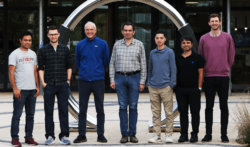
In a major leap forward for the future of artificial intelligence infrastructure, Lumai, the Oxford-born startup pioneering 3D optical computing, has raised more than $10 million in a fresh funding round. The investment — led by deep tech-focused Constructor Capital and backed by notable names such as IP Group, PhotonVentures, Journey Ventures, LIFTT, Qubits Ventures, State Farm Ventures, and TIS Inc. — signals growing confidence in a technology that could reshape the AI compute landscape as we know it.
At the heart of Lumai’s innovation lies a bold ambition: to deliver 50x the performance of today’s silicon-based accelerators at just 10% of the energy cost. And they’re doing it using light.
Why AI Needs a Radical Overhaul
With AI systems like ChatGPT, Claude, and Gemini becoming increasingly sophisticated, the underlying hardware is being pushed to its breaking point. Training and running large language models (LLMs) requires vast computational power — and equally vast amounts of energy. In fact, data center power consumption in the U.S. is expected to triple by 2028, potentially consuming 12% of the national power supply.
But it’s not just about power. It’s about economics and scalability. Traditional silicon GPUs and even integrated photonics are now facing diminishing returns, rising costs, and scalability roadblocks.
Enter Lumai.
What is Optical Computing — and Why Is It a Big Deal?
Unlike conventional chips that move electrons through silicon, optical computing uses photons (particles of light) to perform calculations. This offers three major advantages:
-
Speed – Photons travel faster than electrons and don’t generate heat in the same way, enabling ultra-fast processing.
-
Energy Efficiency – Optical signals reduce power consumption dramatically.
-
Parallelism – Light can handle many operations simultaneously using different paths and wavelengths.
What makes Lumai’s approach truly novel is its use of 3D optical matrix-vector multiplication (MVM) — a key operation in deep learning — carried out in free space. This means that calculations happen as beams of light pass through 3D geometries, rather than on a flat chip.
This technique has the potential to reach 10¹⁷ operations per second — 1000x faster than today’s electronics, and 100x faster than the human brain.
Lumai’s Secret Sauce: 3D Optical Acceleration
Spun out of the University of Oxford, Lumai has tackled a challenge that has stumped researchers for decades: how to scale optical computing reliably and cost-effectively.
Their processor, designed in a PCIe form factor (making it easy to integrate into existing data center infrastructure), performs matrix multiplication — the foundation of neural networks — using light beams that travel in 3D space. This allows for:
-
Extremely wide vector operations
-
High optical clock speeds
-
Near-zero latency inference
-
Massively parallel processing
As a result, Lumai’s solution not only accelerates performance but also drastically cuts down energy use and total cost of ownership (TCO).
“The future of AI demands radical breakthroughs in computing,” said Tim Weil, CEO and co-founder of Lumai. “Current LLMs are unsustainable in cost and power. Our optical computing design overcomes these barriers and enables next-generation AI to flourish.”
Backing From Industry Visionaries
The funding round attracted some of the brightest minds and institutions in tech and venture capital:
-
Constructor Capital’s Dr. Serg Bell called Lumai’s technology “a significant step forward in improving matrix multiplication,” drawing parallels to how quantum computing transforms other computation types.
-
IP Group’s Dr. Lee Thornton emphasized the company’s success in solving optical compute scalability, making it a viable commercial path.
-
PhotonVentures’ Ewit Roos stated that Lumai is “reshaping the future of AI compute,” placing it at the forefront of data center innovation.
And the recognition doesn’t stop there — Lumai has already racked up a slew of accolades:
-
Best Overall Technology at the Global OCP Future Technologies Symposium
-
Selected for Intel Ignite’s prestigious London program
-
Research co-founder Dr. Xianxin Guo joined the Royal Academy of Engineering’s Shott Accelerator
-
Co-founder Dr. James Spall named to the Photonics 100 list for 2025
What’s Next for Lumai?
With the new funding, Lumai plans to:
-
Double its headcount
-
Advance product development
-
Expand into the U.S. market
-
Push toward commercialization of its optical AI inference accelerator
Their roadmap charts a path from 4x performance gains to a full 50x compared to silicon-based competitors — while consuming just 10% of the power. In a world where sustainability, cost-efficiency, and AI acceleration are converging as the next great computing challenge, Lumai is positioning itself not just as a player, but as a pioneer.
Final Thoughts
The AI race is no longer just about smarter algorithms — it’s about smarter infrastructure. Lumai’s 3D optical processors offer a glimpse into a future where AI is not limited by silicon, and where photons become the fuel that powers intelligence at scale.
In an industry hungry for disruptive change, Lumai may just be the breakthrough the world has been waiting for.
The post Lumai Raises $10M+ to Revolutionize AI Compute with Optical Processing appeared first on Unite.AI.



